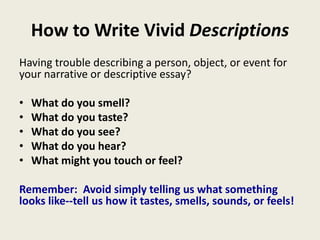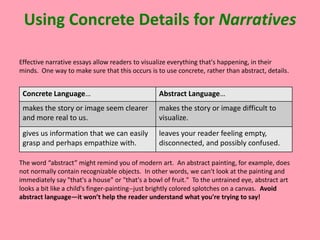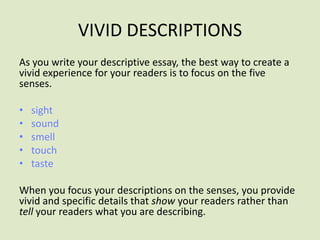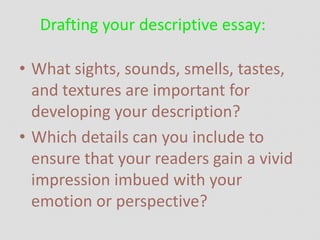English descriptive writing
- 2. âĒ To write a narrative essay, youâll need to tell a story (usually about something that happened to you) in such a way that he audience learns a lesson or gains insight. âĒ To write a descriptive essay, youâll need to describe a person, object, or event so vividly that the reader feels like he/she could reach out and touch it.
- 3. Tips for writing effective narrative and descriptive essays: âĒ Tell a story about a moment or event that means a lot to you--it will make it easier for you to tell the story in an interesting way! âĒ Get right to the action! Avoid long introductions and lengthy descriptions--especially at the beginning of your narrative. âĒ Make sure your story has a point! Describe what you learned from this experience. âĒ Use all five of your senses to describe the setting, characters, and the plot of your story. Don't be afraid to tell the story in your own voice. Nobody wants to read a story that sounds like a textbook!
- 4. How to Write Vivid Descriptions Having trouble describing a person, object, or event for your narrative or descriptive essay? âĒ What do you smell? âĒ What do you taste? âĒ What do you see? âĒ What do you hear? âĒ What might you touch or feel? Remember: Avoid simply telling us what something looks like--tell us how it tastes, smells, sounds, or feels!
- 5. Using Concrete Details for Narratives Effective narrative essays allow readers to visualize everything that's happening, in their minds. One way to make sure that this occurs is to use concrete, rather than abstract, details. Concrete LanguageâĶ Abstract LanguageâĶ makes the story or image seem clearer makes the story or image difficult to and more real to us. visualize. gives us information that we can easily leaves your reader feeling empty, grasp and perhaps empathize with. disconnected, and possibly confused. The word âabstractâ might remind you of modern art. An abstract painting, for example, does not normally contain recognizable objects. In other words, we can't look at the painting and immediately say "that's a house" or "that's a bowl of fruit." To the untrained eye, abstract art looks a bit like a child's finger-painting--just brightly colored splotches on a canvas.âĻAvoid abstract languageâit wonât help the reader understand what you're trying to say!
- 6. EXAMPLES! âĒ Examples: âĒ Abstract: It was a nice day. âĻConcrete: The sun was shining and a slight breeze blew across my face. âĒ Abstract: I liked writing poems, not essays. âĻConcrete: I liked writing short, rhythmic poems and hated rambling on about my thoughts in those four-page essays. âĒ Abstract: Mr. Smith was a great teacher. âĻConcrete: Mr. Smith really knew how to help us turn our thoughts into good stories and essays.
- 7. HOW TO WRITE A DESCRIPTIVE ESSAY Here is a list of important rules to follow as your write this essay. âĒ Understand the concept âĒ Do your research âĒ Outline the paper âĒ Write the paper âĒ Re-write the paper âĒ Edit (outside editors) Here are some tips to remember when writing your descriptive essay: âĒ Actually describe something âĒ Use concrete and abstract images âĒ Use concrete and abstract ideas âĒ Do not go overboard with adjectives and adverbs âĒ Do not go overboard with similes and metaphors âĒ Give it to someone else to see if your essay actually describes something
- 8. What do you want to describe? As you get started on your descriptive essay, it's important for you to identify exactly what you want to describe. Often, a descriptive essay will focus on portraying one of the following: âĒ a person âĒ a Place âĒ a memory âĒ an experience âĒ an object
- 9. How should you write your description? If there's one thing you should remember as you write your descriptive essay, it's the famous saying: show don't tell. But what's the difference between showing and telling? Consider these two simple examples: âĒ I grew tired after dinner. âĒ As I leaned back and rested my head against the top of the chair, my eyelids began to feel heavy, and the edges of the empty plate in front of me blurred with the white tablecloth. The first sentence tells readers that you grew tired after dinner. The second sentence shows readers that you grew tired. The most effective descriptive essays are loaded with such showing because they enable readers to imagine or experience something for themselves.
- 10. VIVID DESCRIPTIONS As you write your descriptive essay, the best way to create a vivid experience for your readers is to focus on the five senses. âĒ sight âĒ sound âĒ smell âĒ touch âĒ taste When you focus your descriptions on the senses, you provide vivid and specific details that show your readers rather than tell your readers what you are describing.
- 11. PLANNING YOUR DESCRIPTIVE ESSAY
- 12. Drafting your descriptive essay: âĒ What sights, sounds, smells, tastes, and textures are important for developing your description? âĒ Which details can you include to ensure that your readers gain a vivid impression imbued with your emotion or perspective?
- 13. Revising your descriptive essay: âĒ Have you provided enough details and descriptions to enable your readers to gain a complete and vivid perception? âĒ Have you left out any minor but important details? âĒ Have you used words that convey your emotion or perspective? âĒ Are there any unnecessary details in your description? âĒ Does each paragraph of your essay focus on one aspect of your description? âĒ Are you paragraphs ordered in the most effective way?
- 14. âĒ A scream passing through an open window at the edge of town rattles the settled sounds of a night tucked in, the filtering whispers of leaves outside in the breeze interrupted, yielding to the call of a helpless exater protected by sound walls; only the nearby creek persists. Call of crickets resign under full moon, and hill-riding wind halts for a moment following the cry. Slowly, the leaves begin to whisper again, though slightly muffled, offset by the impression of a scream when it was the last thing on the nightâs mind. âĒ Like his twisted feathers, his many scars, the reliable old owl chose the gnarled, weather-beaten, but solid branch oftenâit being a companion to the wise alone with the night and the last branch to creak in the heaviest wind. He oft...
- 15. APPLE! âĒ The next time you get a chance, pick up an apple. Feel the weight of it in your hand. Examine it for blemishes. What caused that little black spot? Did the apple tenaciously hang onto the wind- whipped tree branch as a storm dashed it into a neighboring twig? Did a peckish bird sample the apple for ripeness? Look at the apple again and feel it as it warms in your hand. Anticipate the burst of flavor as your teeth crunch through the rich redness of its thin skin.
- 16. The above is a sample of descriptive writing and a hint of some of the ways you can take an ordinary object and change it into the extraordinary using words. Writing a descriptive essay is a chance to explore your own creativity as you use the senses to draw a picture in words. âĒ Could you feel the weight and temperature of the apple? âĒ Did you see the blemish and visualize the windstorm or the bird? âĒ Could you hear the crunch as you bit through the skin? âĒ Could you taste the explosion of flavor?
- 17. Actually, there is more than one way to write a descriptive essay. Some descriptive essays are written objectively, using only the facts: Example: The apple was fully ripe, a fact supported by its deep red color and the ease with which its dry brown stem separated from the tree. âĒ Tip: Keep your essay on topic by applying descriptive text to your subject only. Notice above that no description is applied to the tree. Other descriptive writing, like the first example, is subjective in that it intends to paint a vivid picture that elicits sensations or arouses emotion in the reader. However, in either form, descriptive writing adds strength to your essay by adding interesting and specific details to your composition.
- 18. âĒ Although the first example is a descriptive paragraph, be sure to follow the standard essay writing format of introduction, body, and conclusion when writing your descriptive essay. Use your introduction to both present your subject and to tell your reader why you found it interesting. âĒ Choose your details carefully. In writing a descriptive essay, your objective is to leave your reader with just one impression. âĒ For instance, if the apple was grass green instead of rosy red, you might take some âpoetic licenseâ and leave that fact out, selecting only the details that support your description and convey the impression or a ripe and juicy apple.
- 19. When writing a descriptive essay, start building your description by brainstorming the facts: âĒ Red Apple âĒ Brown Stem âĒ Small black blemish near the top âĒ Thin skin âĒ Juicy âĒ Crunchy âĒ Round âĒ Heavy and solid
- 20. âĒ By the time you finish this process, youâll probably have written an objective description and only need to put it into sentences and insert them into appropriate paragraphs of your descriptive essay. In writing a subjective description, youâll want to build on the facts by adding adjectives to some of them and using synonyms that are more descriptive for others. (e.g. rosy red as opposed to red or weighty as opposed to heavy). âĒ Choose two or three of the descriptions youâve built and use them as the focal points of your descriptive essay body, with supporting information that describes why they are important to your overall view. (In this example, the ripeness of the apple.) âĒ Conclude your descriptive essay with a summary of your points and restate the impression you meant to create.
- 21. PURPOSE OF DESCRIPTIVE ESSAYS âĒ The purpose of a descriptive essay is to describe a person, place, or thing in such vivid detail that the reader can easily form a precise mental picture of what is being written about. The author may accomplish this by using imaginative language, interesting comparisons, and images that appeal to the senses. âĒ Read this sample descriptive essay, and then read the notes below.
- 22. 1) The subject of the sample essay is fairly ordinaryâa ride on a Ferris wheel. The author makes it interesting, however, by comparing the Ferris wheel to a monstrous creature.âĻ 2) The author makes good use of fresh and varied vocabulary. For example, in the first paragraph alone, she uses verbs that create excitement like "fascinate," "amaze," and "terrify." In the second paragraph she uses a variety of terms to describe the machine such as "monstrosity," "mythical beast," "amazing dinosaur," "fire-breathing dragon."
- 23. 3) The author uses her senses to describe the sceneâhow the ride looks, sounds, smells, and feels. The ride is "huge, smoky, noisy" and its engines "drone" like the roar of a dragon. On the ride, she gets a "rush of adrenaline" and a "lump in her throat," she feels immobile and then weightless.âĻ 4) The essay is well organized. The introduction begins with a general statement, "I have always been fascinated by carnival rides," and ends with a more specific statement of what the essay will be about, "the thrill and excitement of a carnival ride keeps me coming back for more." The body of the essay is composed of several paragraphs that describe the Ferris wheel, the way it seems from the ground and the way it feels to ride on one. The conclusion restates the main idea of the essay, that the author continues to find carnival rides thrilling and exciting.






















